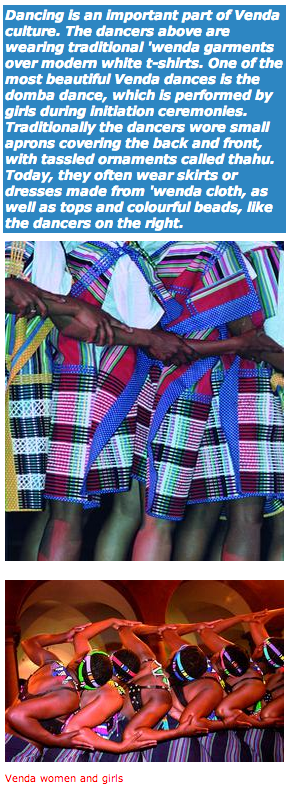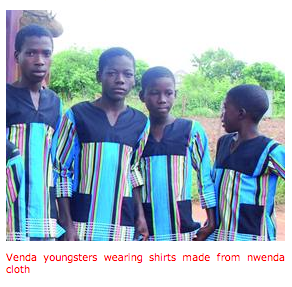CELEBRATING OUR HERITAGE
VENDA TRADITIONAL DRESS
Venda women and girls
The most colourful part of Venda women's clothing is the upper garment made from multi-coloured striped cloth called 'wenda. It is a length of cloth with a strip (bannda) sewn on across the top and two straps (mivhofho) of the same cloth to tie over the shoulder.
A traditional garment which was worn only by married women, is a goat skin apron called tshirivha, covering the back and front. On special occasions, married women used to wear a ceremonial back apron made of sheepskin called gwana. Today, a similar garment is made of 'wenda cloth. Maredo, worn by young females, are narrow strips of cloth hanging between the legs over a girdle in the front and back. Bracelets and necklaces of twisted grass called vhukunda were worn by females for decoration. Young women also wore pieces of copper twisted round a string of cotton, called thuthu or shedo, round the ankles and wrists.
Venda men and boys
A loin cloth called tsindi is an important item of clothing traditionally worn by all Venda males. It is a triangular piece of soft skin covering the front, passed between the legs and tied at the back. Tsindi worn by mature men were made from the skin of a goat, klipspringer or duiker. A rope called ludede was worn around the waist. In cold weather, Venda men also wore a cloak over the shoulders called nguvha. It was usually made by young men from a complete goat's skin. The chief traditionally wore an animal skin headband and a karos or sila over his shoulders.
Today, Venda men often wear shirts made from the traditional striped 'wenda cloth. Sometimes they wear a length of 'wenda cloth tied across one shoulder.
- Information supplied by the University of Venda




 Facebook
Facebook Twitter
Twitter WhatsApp
WhatsApp